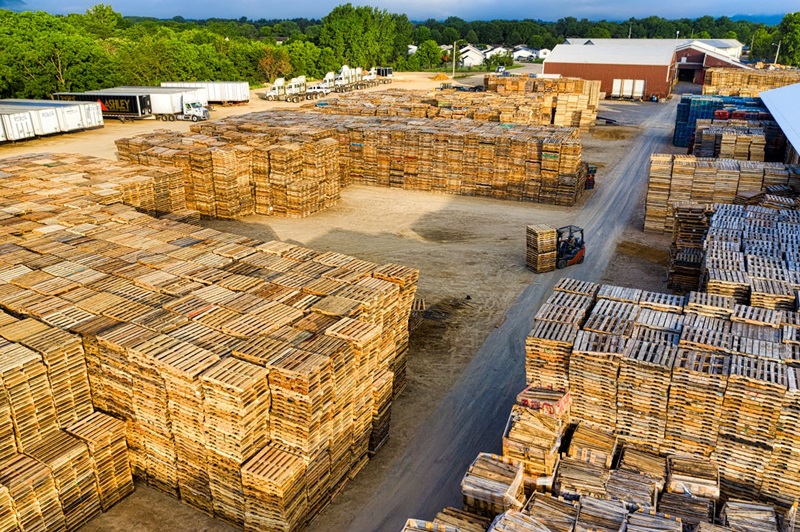Do you ever find yourself rummaging through salvage yards or antique shops, hunting for that unique piece that will add a touch of character to your home? Have you ever considered the potential lying idle in those stacks of worn, wooden pallets? What if we told you that used pallets carry an untapped reservoir of innovation and practicality that could transform your dwelling – would your interest be piqued? It's time to delve into the intriguing realm of used pallets and understand the potential benefits and pitfalls of their use.
In this article, we'll lift the lid off the incredible versatility of used pallets, put to use in myriad ways unimaginable. Pallets have consistently proven themselves as more than mere transport material, evolving significantly in the modern design space for their versatility, sustainability, and overall appeal. Combining both style and practical functionality, these humble structures play a pivotal role in the interior design scene.
 |
| Used Pallets |
The possibilities are endless, with each pallet carrying its unique history and charm. A DIY project with used pallets can result in a beautiful piece that adds tangible value to your home both in form and function. Let's explore together the distinct types of used pallets, their potential uses, and tips on how to choose the perfect one for your next home improvement project.
The Charm and Versatility of Used Pallets
Why is there such a buzz around pallets? For starters, they are affordable and easily accessible. Salvaged pallets are a sustainable choice, allowing you to repurpose materials that might otherwise end up in the landfill. The rustic character of pallet wood adds warmth and visual interest - perfect for those seeking a balance between style and practicality.
The most striking appeal of pallets lies hidden within their simple, unassuming design. When skillfully utilised, these ordinary structures morph into everything from bed frames and bookshelves to outdoor planters and desks. Essentially, pallets have the power to transform your house into a cosy, personalised sanctuary infused with creative flair.
Then there’s the undeniable satisfaction derived from crafting a functional, bespoke piece with your own hands. DIY pallet projects let you express creativity, while also creating functional items that can significantly enhance your living spaces.
Decoding Pallet Types: The Hidden Language of Pallets
Understanding the language of pallets is the first step towards successfully repurposing them. There are various types of pallets, each with different strengths, drawbacks, and best uses.
Perhaps the most familiar type is the stringer pallet, constructed with three long pieces of wood (or 'stringers') supporting the structure. Alternatively, there's the block pallet design, distinguished by its use of square blocks to support the unit. These variations influence the pallet's strength, durability, and potential uses.
Another element adding to the complexity of pallet selection is the type of wood used. Hardwood pallets, such as oak or maple, are strong and durable, but also harder to work with. Softwood pallets, like pine, are easier to modify but may lack the sturdiness of their hardwood counterparts. Knowing your needs and the constraints of your project is crucial when selecting the perfect pallet.
Unveiling the Pros and Cons
Like any material, pallets come with their pros and cons. One of the greatest advantages is undoubtedly their affordability. Most times, you can find used pallets for little to no cost - a distinct edge for introspective homeowners and DIY enthusiasts.
Furthermore, the rustic aesthetic of pallet wood brings charm and character to any space. There's also the sustainability angle: rather than depleting new resources, using reclaimed pallet wood is environmentally conscious.
On the downside, it is essential to be aware of certain considerations. Pallets are often treated with chemicals to repel pests or to increase their longevity. They can also harbour bacteria or fungus, especially if they've been exposed to wet conditions. Ensuring your pallets are safe for indoor use before starting your project is always a must.
Making the Critical Selection
Choosing the right pallet for your project involves looking beyond the superficial wear and tear. You need to consider the shape, size, and integrity of the entire structure.
Understanding the International Plant Protection Convention (IPPC) stamp on the pallet will also help direct your choice. The IPPC stamp will indicate if the pallet has been chemically treated or heat-treated - knowledge that’s invaluable if you're considering using the pallet in the indoors.
Conclusion
If you've followed this journey of pallet exploration, you've likely realised how these once-overlooked entities hold abundant potential. With their transformative versatility, sustainable appeal, and affordability, they offer a winning combination for home improvement crusaders.
However, as we've noted, it's essential to be mindful of the used pallet selection, ensuring safety and functionality, and understanding the treatments used. Your diligence here will let you harness the raw beauty and practicality of used pallets without any negative implications.
So why not let your creative juices flow and embark on your own pallet project journey? Embrace the imperfections, the rustic charm, and most importantly, the unique story that each pallet encapsulates. In the world of used pallets, you'll find not only an avenue for self-expression but also a chance to make sustainable, quality choices for your home improvement projects.






Post a Comment
Note: only a member of this blog may post a comment.